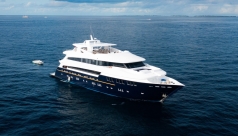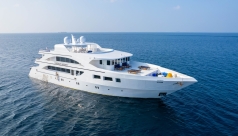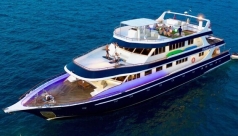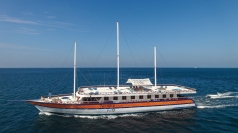Dive Destinations
Liveaboards
Resorts / Day Trips
Scuba Training
Although the Maldives are known the world over for the stunning beaches and azure waters that typify the tropical idyll, its life beneath the water's surface is becoming ever more respected by scuba divers in the know. Whale sharks, manta rays and even hammerhead sharks are regularly seen on a single Maldives liveaboard vacation in the Central Atolls!
Ari Atoll is widely accepted as being the leading atoll for scuba diving in the Maldives. There are sites scattered all around Ari Atoll and they provide the full range of underwater adventure, meaning there is something for everyone. It also means that the atoll is ideally suited for liveaboard tours. The innumerable underwater pinnacles that typify the diving here are hotbeds of marine life, and you can expect to see greater fish density in this location than other parts of the country.
Often the first thing people think of when they consider a Maldives diving safari is sites full of sharks, including whale sharks and hammerheads, and manta rays. Athough there are many good places for these elsewhere in the island chain, it is Ari Atoll that can lay claim to many of the best. Maaya Thila is one of Ari's typical pinnacles surrounded by an outrageous amount of marine life. Diving here is like jumping into the most populated aquarium imaginable. Fish Head is another populous pinnacle where sharks can be present in big numbers; and if sharks are your thing then an early morning dive at Hammerhead Point simply must be on your agenda. Other dive locations include Broken Rock, Fesdu wreck and Kudarah Thila. [More details on these dive sites: Ari Atoll.
North Male Atoll is an area of the Maldives that is quite sparsely populated but has a great concentration of dive sites. However, the sites are well spread and best visited by liveaboard. Sites frequented on diving safaris tend to have topographical features such as caves, drop-offs and reefs. It is also one of the areas that can boast places that feature pristine coral coverage; something that thanks to El Niño cannot genuinely be said of some other parts of the country. Manta Point is a cleaning station not to be missed, while the famous Girifushi Thila is a visual assault of riotous colour and marine life. Other sites you are likely to enjoy include The Maldives Victory, Lion's Head and Okobe Thila. [More details on these dive sites: North Male.
South Male Atoll is considered to be one of the best diving areas in the Maldive Islands due largely to the currents which gush through the channels and therefore support an astonishing number of marine creatures. Scuba divers do not come to South Male to look for pristine hard corals but rather to investigate colourful caves and overhangs, be surrounded by vast schools of reef fish, spot large pelagic fish, and marvel at the variety of colourful soft corals. Cocoa Thila is quite typical of South Male, where you can hover in an overhang sheltered from the current and check out the rays, sharks and schools of fish enjoying the current. Guraidhoo Kandu South supports the great abundance and variety of life that makes South Male a great area to dive in. Other sites you will explore include Kuda Giri Wreck, Vadhoo Caves and Medhu Faru. [More details on these dive sites: South Male].
The vast majority of Maldives liveaboard trips tour the central region on cruises called Maldives Central Atolls. This is not simply due to the convenience of access to Male International Airport. The atolls of North Male, South Male and Ari Atoll provide an amazing array of dive sites within a quite small geographic area. These central routes deliver what many people want from the Maldives: encounters with whale sharks and manta rays, lots of healthy reefs and schools of fish. Most central atoll cruises are for 7 nights although there are sometimes longer, but never shorter, ones. You will need at least a week for liveaboard diving in the Maldives.
There are other itineraries that visit the central atolls and venture slightly further south. These Maldives Southern & Central Atolls cruises can also include Rasdhoo, Meemu and Felidhoo atolls. The Maldives Northern & Central Atolls cruises visit the central region plus Baa Atoll and its renowned Hanifaru Bay. The trips may also be for as little as 7 nights, but are more usually 10 or 11 nights in duration.
> [More details: Central Atolls Trips]
Customer rating: Very good!

Customer rating: Good

Customer rating: Good

Customer rating: Average

Customer rating: Excellent!

Customer rating: Excellent!

Customer rating: Excellent!

Customer rating: Excellent!

Customer rating: Excellent!

Customer rating: Excellent!

Customer rating: Excellent!

Customer rating: Excellent!

Customer rating: Excellent!

Customer rating: Excellent!

Customer rating: Excellent!

Customer rating: Excellent!

Customer rating: Very good!

Customer rating: Very good!

Customer rating: Very good!

Customer rating: Very good!

Customer rating: Very good!

Customer rating: Very good!

Customer rating: Very good!

Customer rating: Very good!

Customer rating: Good

Customer rating: Good

Customer rating: Good

Customer rating: Good

Customer rating: Average

Customer rating: Below average

Customer rating: Be first to rate!

Customer rating: Be first to rate!

Customer rating: Be first to rate!

Customer rating: Be first to rate!

Customer rating: Be first to rate!

Customer rating: Be first to rate!

Customer rating: Be first to rate!

Customer rating: Be first to rate!
The recommended months for confirmed liveaboard departures are from November to May but the Maldives scuba diving season runs all year round. The northeast monsoon (winds from the northeast) runs from the end of December to May. At this time of year the skies are blue and the lack of wind means the seas are calm. The visibility on the eastern side of the atolls is good at 20-30+m, and 15-20m on the western sides. The eastern atolls generally have the best visibility during this time too, and December to March normally enjoys the best overall visibility. This is because the currents flow through the atoll channels from east to west. Reef sharks gather in large numbers at the channel entrances on the eastern side of the atolls; whereas mantas are drawn to the western sides because plankton flows out of the channels into open sea to the west at this time. The current is strongest at this time of year too.
June to November is the southwest monsoon and the above process is reversed - currents run through the channels in an easterly direction; mantas to the east, reef sharks and better visibility to the west. The skies are cloudier, the winds are stronger and seas a little rougher, although the season does still get nice, sunny spells. Surface swells can reach 1-2m, particularly during the rainy season in June/July, when rain falls on average 3-4 hours per day, and during the monsoon transitions in late May and early December. It may be more difficult to find a liveaboard departure date in the Maldives that suits you in this period.
Water temperatures are fairly constant throughout the year at 26-29°C, except in the far south where the water temperature can drop to 24°C during the northeast monsoon. Having said all that, like most places in the world, the seasons in the Maldives have become less predictable in recent years.
Mantas, whale sharks, turtles, reef sharks and hammerhead sharks are found in the Maldives all year round; if anything, manta rays are found in even greater numbers in the southwest monsoon. As for the other big creatures, diver encounters are dependent on non-seasonal factors: whale sharks are more frequently sighted at high tide, and hammerhead sharks ascend to shallower water at sunrise.
Liveaboards that cruise the Central Atolls use Hulhule, next to Male International Airport, as their operating port. This means that guests can have a hassle-free transfer from the airport arrivals hall to their boat. You might even arrive in Maldives and be diving on the same day! Everyone flies into Male Airport and you will be met there by representatives of the cruise. More information on: how to get to the Maldives.
For your peace of mind, we strongly advise securing comprehensive insurance coverage for all diving and travel activities, including protection against trip cancellations. Our recommended insurance program offers competitive rates tailored specifically for dive vacations. Request a personalised quote when booking your stay:
For convenient pre- or post-liveaboard safari stays in the Maldives, our trusted partner HotelsCombined.com offers an extensive selection of accommodations. Their platform features easy online browsing with instant chat support, secure credit card bookings, and 'Best Price Guarantee' for maximum value. Book your perfect stay at www.hotelscombined.com:
Travel Tip: If you have a layover in Malé, consider booking a day room at an airport hotel on Hulhule Island or in the city center. These provide shower facilities, luggage storage, and a comfortable base to explore before your onward journey.
We've used Dive the World twice now for Maldives and Fiji and really like the service. Instructions are detailed and clear and the staff is responsive. Great job Pip and Beef :) We are happy with the service and will use Dive The World again.
